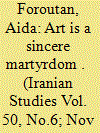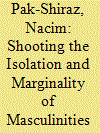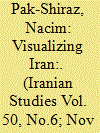| Srl | Item |
| 1 |
ID:
155084


|
|
|
|
|
| Summary/Abstract |
This paper focuses on various aspects of Alireza Espahbod’s style of painting that encrypt his work. The period considered is from the just after the Iranian revolution until the artist’s death in 2007: in these years censorship had become severe, resulting in banning prohibition on his work being exhibited. Apart from the striking symbols that recur throughout his work, it is noticeable that he favors certain visual metaphors for encryption of humanitarian and satirical meanings. The discussion also focuses on the ways in which sequences of his individual paintings create narratives, like scenes in a play or a film. Unlike some preceding modernists, Espahbod is firmly rooted in his Iranian cultural milieu, and is in a line of artists who have used surrealism, beginning with Sadegh Hedayat in the modern literary world. He also follows a much older tradition that goes back to classical poetry and miniature art, in which image and word coalesce and are interchangeable, and where literature and visual art reflect one another. He uses these older techniques to comment allusively on the dramatic events and conditions of his own time. It is argued that his work amounts to more than that of an artist who merely fought against censorship, as his art rises above it and responds to it with a positive message for his audience.
|
|
|
|
|
|
|
|
|
|
|
|
|
|
|
|
| 2 |
ID:
155082


|
|
|
|
|
| Summary/Abstract |
This paper has two purposes. One is to look carefully at the way that the stories of Sālih and Samson are told in the Edinburgh fragment of Rashīd al-Dīn’s World History and its accompanying illustrations, and the messages that these convey. The second is to explore the interplay of text and image in what might be termed “the Moses cycle” and to consider the motivation for the unusual textual and pictorial emphasis on Moses. Several aspects of the cycle are analyzed: Moses as an antetype of Rashīd al-Dīn himself, the impact of the Qur’anic text and Moses as a precursor of the Prophet Muhammad.
|
|
|
|
|
|
|
|
|
|
|
|
|
|
|
|
| 3 |
ID:
155081


|
|
|
|
|
| Summary/Abstract |
The Arabic copy of Rashid al-Din’s Jāmiʿ al-tavārīkh dated 714/1314‒15 and divided between Edinburgh University Library (Or. ms. 20) and the Khalili Collection in London (ms. 727) is of seminal importance as one of the first and most extensively illustrated histories produced in Iran. This article examines four paintings from the manuscript to suggest why the patron wanted to add illustrations and how artists in his atelier adopted and adapted elements from Chinese painting in order to disseminate the text and enhance its meaning.
|
|
|
|
|
|
|
|
|
|
|
|
|
|
|
|
| 4 |
ID:
155085


|
|
|
|
|
| Summary/Abstract |
This paper examines a range of post-revolutionary Iranian art films, mostly those watched primarily outside the country via festival screenings, in the context of the relationship between the tropes of peripherality and humor. It argues for the significance and complexity of both terms in the context of this cinema and of the global image of Iran and its peoples. Having examined a kind of humor based on the geographic periphery, specifically derived from relationships between technology, car, and camera, it concludes by reflecting on the advent of new technologies, and social constraints and opportunities in the Iranian art cinema today.
|
|
|
|
|
|
|
|
|
|
|
|
|
|
|
|
| 5 |
ID:
155083


|
|
|
|
|
| Summary/Abstract |
Having been introduced to the scholarly community and the general public through a variety of photographic presentations during the inter-war period, monuments in Iran, particularly those of pre-modern Islamic periods, became key buildings to be seized upon as the ultimate embodiment of Persian beauty. The lasting image of Persian Islamic architecture that was articulated through photographs continues not only to set an important benchmark for the understanding of the aesthetic and political matrix of the early twentieth century but also to provoke a methodological question as to the future of Persian architectural studies.
|
|
|
|
|
|
|
|
|
|
|
|
|
|
|
|
| 6 |
ID:
155079


|
|
|
|
|
| Summary/Abstract |
The Persians held sway over the Greek imagination for more than 200 years. The image of Persia shifted in that time from xenophobic hostility, caused through fear of the encroaching presence of the Persian empire, through to curious acceptance of its dominance. Much study has been given to the formative decades of the construction of the Persian “Other” in Greek art, but the fourth-century image of Persia has remained relatively unexplored. This paper demonstrates how Greek artists of the period 380–330 BCE fixated on the life and accomplishments of the court of the Achaemenid Great Kings and argues that instead of offering an orientalist clichéd view of Persian life, it attempted to understand and disseminate bone fide Iranian images of court society.
|
|
|
|
|
|
|
|
|
|
|
|
|
|
|
|
| 7 |
ID:
155086


|
|
|
|
|
| Summary/Abstract |
This article examines the isolation and marginality of Iranian men living in contemporary Iran with a focus on three post-2005 films. As a patriarchal society, Iran has been the subject of many studies on the subjugation and marginality of women. This study demonstrates how recent Iranian films have skillfully employed the cinematic language to narrate men’s stories of alienation and despair. These filmic constructions provide a valuable and complex insight into masculine identities, challenging perceptions of the essentialized image of the Middle Eastern male. By employing Connell’s hierarchy of masculinities, the article demonstrates the position of marginalized men in relation to the dominant ideals of masculinity and the influence of these discourses on the lives of such men. The films discussed here do not perpetuate the construction of the ‘true’ gender, but instead challenge ideas of heroism, manliness and patriarchy.
|
|
|
|
|
|
|
|
|
|
|
|
|
|
|
|
| 8 |
ID:
155078


|
|
|
|
|
| Summary/Abstract |
This special issue brings together eight articles that examine the visualization of Iran ranging from the Achaemenids to contemporary Iranian society, providing a glimpse into the array of representations in and of Iran. Even as a snapshot they allow a bird's-eye view of the historic role of visual culture in shaping, influencing, and transforming Iranian cultures over successive centuries. An immensely rich visual culture has always existed in Iran and the surrounding regions, often shaped by encounters with different zones of contact and patronized by ruling elites and dynasties with myriad artistic and cultural traditions, needs, and agendas. This special issue is a tribute to that rich cultural history.
|
|
|
|
|
|
|
|
|
|
|
|
|
|
|
|
| 9 |
ID:
155080


|
|
|
|
|
| Summary/Abstract |
Relationships between power and architecture are a feature of all great civilizations and the Achaemenid world was no exception to this. The architecture of Achaemenid buildings and their relief sculpture was designed to reflect and reinforce the power and status of the Great King. At the heart of this visual program lay the audience hall (apadāna) at Persepolis. In seeking to explain and understand the messages written into this building, we tend to approach the structure as a completed work and view it from the last point in its lifecycle. As a result, we focus on its tribute procession relief and allow ideas of empire to dominate our gaze. This limits our ability to understand how and why the building’s intended audience and message of power might have diverged at different stages in its construction. This article re-examines the art and architecture of the audience hall at Persepolis and redirects the viewer’s gaze to the images of bulls rather than the tribute procession. In focusing on the role of bulls in the scheme of decoration, the article presents a more nuanced reading of the building in its historical, social and architectural context. It shows how Darius I used the Persepolis apadāna to display his authority to rule and to assert the primacy of his status amongst his fellow elites.
|
|
|
|
|
|
|
|
|
|
|
|
|
|
|
|